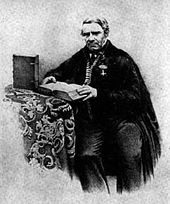Johann Michael Ackner
Johann Michael Ackner (born January 25, 1782 in Schäßburg , Transylvania , † August 12, 1862 in Hammersdorf near Hermannstadt , Transylvania) was an archaeologist and naturalist .
Ackner is considered a co-founder of German research in Transylvania. He gained special recognition for his work on archeology and geology.
life and work
Johann Michael Ackner attended the Bergschule Schäßburg and the grammar school in Sibiu. He later studied theology in Wittenberg and Göttingen , but also philosophy, history, natural sciences, comparative anatomy and the history of medicine , philology and archeology .
After a long study trip through Europe, Ackner settled in Sibiu in 1808 as a high school teacher for philology and archeology. In 1821 Ackner was elected pastor in Hammersdorf. There he found enough time to devote himself to his studies. In the course of his extensive travels, Ackner turned from 1829/30 more and more to mineralogy and geology and then above all to archeology. In 1851 he was elected a member of the Leopoldina .
His restless scientific work was honored with the Golden Cross of Merit with the Crown in 1854 and with the title Imperial Councilor in 1858.
In 1860, at the age of 78, Ackner was able to travel to Vienna via Trieste and Venice for scientific purposes.
Ackner was married from 1810 - so 52 years - to Maria Magdalena Ebner and had twelve children with her.
Fonts
- Antiqua musei Parisiorum monumenta. Sibiu 1809.
- with Johann Karl Schuller : The Hermannstädter See in the Grand Duchy of Transylvania (Land of the Saxons.). HF Müller, Vienna 1840 ( digitized version ).
- Mineralogy of Transylvania with geognostic hints. Steinhaussen, Hermannstadt 1847 (digital copies: T. 1 ; T. 2 ); New edition 1855 ( digitized ).
- Contribution to the geognosy and petrefacts of southeastern Transylvania, especially the layers from the area of the Hermannstaedter Basin: Received at the academy on November 12, 1851. In: Nova acta Academiae Caesareae Leopoldino-Carolinae Germanicae Naturae Curiosorum. Vol. 24 (1854), 2nd Dept., No. 8, pp. 897-936.
- The Roman colonies and military camps in Dacien in what is now Transylvania. Court and State Printing House, Vienna 1857.
- The Roman antiquities and German castles in Transylvania with an overview map. Court and State Printing House, Vienna 1857.
- with Friedrich Müller : The Roman inscriptions in Dacien. Tendler, Vienna 1865 ( digitized version ).
literature
- Constantin von Wurzbach : Ackner, Michael Johann . In: Biographisches Lexikon des Kaiserthums Oesterreich . 1st part. University book printer L. C. Zamarski (formerly JP Sollinger), Vienna 1856, p. 4 ( digitized version ).
- Ferdinand Zieglauer von Blumenthal: Ackner, Johann Michael . In: Allgemeine Deutsche Biographie (ADB). Volume 1, Duncker & Humblot, Leipzig 1875, p. 39 f.
- Ackner Johann Michael. In: Austrian Biographical Lexicon 1815–1950 (ÖBL). Volume 1, Publishing House of the Austrian Academy of Sciences, Vienna 1957, p. 4.
- Volker Wollmann: Johann Michael Ackner (1782–1862). Life and work. Dacia, Cluj 1982.
- Richard Ackner: Ten generations of Ackner: family papers and results of genealogical research on ancestors in Transylvania. Supplemented version. Family print and for Transylvanian libraries, Neubrandenburg 2001
| personal data | |
|---|---|
| SURNAME | Ackner, Johann Michael |
| BRIEF DESCRIPTION | Transylvanian archaeologist and naturalist |
| DATE OF BIRTH | January 25, 1782 |
| PLACE OF BIRTH | Schäßburg |
| DATE OF DEATH | August 12, 1862 |
| Place of death | Hammersdorf near Sibiu, Transylvania |


